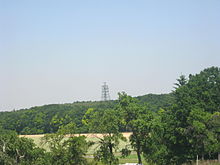Thum missile station
The former Thum missile station is located northeast of Thum , a district of Kreuzau , North Rhine-Westphalia on the edge of the former Drover Heide military training area . The former military facility from 1962 can be recognized from afar by the - formerly red and white - steel girder tower , which is now used by mobile phone providers and is painted gray.
The Nike-Hercules -Launching Area is a former Nike-Ajax position and was operated by the Belgian military . The site covered an area of 632 hectares. The Nike Ajax missiles had a two-stage propulsion system, had a range of around 40 kilometers and could soar to an altitude of around 20 kilometers. The disadvantage of this missile was that it could only transport conventional warheads and also had to be partially refueled with dangerous liquid fuel.
The area next to the Ajax position was built around the end of the 1960s. This then led to the fact that from 1966 a new firing position for the more modern Nike-Hercules missiles was built in the immediate vicinity . With a four-stage drive, these reached a range of 130 kilometers and a height of 30 kilometers. The use of solid fuel made dangerous refueling unnecessary. The Nike Hercules could now also transport nuclear warheads. With the new type of missile, Americans also moved into the position who were storing nuclear warheads there. The Belgians now only secured the area in an outer ring.
Atomic anti-aircraft missiles of the Nike type were stationed in the Thum position. Two versions of nuclear warheads were available, the smaller B-XS with an explosive force of two kilotons, the larger B-XL originally had an explosive force of 40 kilotons. The latter were exchanged for warheads of 20 kilotons in the 1970s. A maximum of ten nuclear warheads were available per position, eight with strength XS with two kilotons and two XL with 40/20 kilotons of explosive force.
Today you can still find the four launching areas and two bunkers ( double-section bunkers ) of the Nike-Ajax position , which are each located between two launching areas. The adjacent Nike-Hercules position is not freely accessible.
There were 54 batteries in the Federal Republic of Germany, eight of which were under Belgian, four under Dutch, 24 under German and 16 under US orders. They were integrated into NATO's air defense system NADGE (NATO Air Defense Ground Environment). A battery typically had 30 guided missiles and nine launch devices (“launcher”). The Nike positions had an average distance of 30 kilometers and lay along the intended line of retreat of the NATO troops along the Rhine and the North Sea coast area. The range of the guided missiles was between 30 and 150 kilometers. Most Nike systems were decommissioned in April 1974 due to the SALT-1 agreement . Today the area belongs to the Federal Republic of Germany. The gate is open, which means that the site is freely accessible.
Since January 7, 2019, almost all the buildings on the 1.3 hectare site have been demolished. Only three earth bunkers remain as shelter for bats; 20 buildings and the watchtower fall victim to the excavators. The former military site will then be "fenced off" and added to the Drover Heide nature reserve again. The property is owned by the NRW Foundation .
Web links
- Entry on the launch area of a Nike missile position near Vettweiß in the database " KuLaDig " of the Rhineland Regional Association
- Nike Thum in "Forum Traces of History"
- NIKE 50.Sd Nideggen (BE) in "Cold War Forum"
- Nideggen in "Atomwaffen A – Z"
- Demolition in Aachen local time
Individual evidence
- ↑ https://www.aachener-zeitung.de/lokales/dueren/kreuzau-militaergelaende-thum-wird-abgerissen_aid-34745355
Coordinates: 50 ° 42 ′ 46 ″ N , 6 ° 32 ′ 3.2 ″ E

